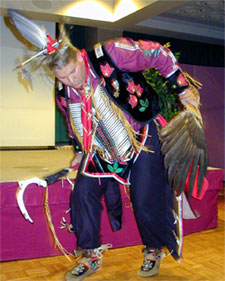|

Ojibwe Traditional
Dancer
|
In a study done in
1995 in Hennepin County, health care providers identified the following
barriers to health care as they perceived problems caring for patients
from cultures other than their own (Ohmans, 27-29).
- Gender: In traditionally
sensitive areas of health care, gender is extremely important. One may
be caring for a torture survivor and therefore the gender issues become
critical. Also certain cultural groups will not allow a person of the
opposite sex to touch them.
- Class: There is
a strong tie between a patient's social status and educational attainment,
which in turn affects health behavior. Not all refugees are poor, but
many have had significant class changes when immigrating to the United
States.
- Age: This barrier
varies greatly from young to old and among various cultures. Providers
should be sensitive to the age factor when caring for a person of any
culture.
- Intrusive or invasive
procedures: Practices involving removal of blood or tissue or invasive
procedures are difficult for many immigrant patients. Try to negotiate
with patients about the amount taken or timing of the procedure whenever
possible.
- Systems differences:
Western medicine is seen as highly mechanistic. It does not take into
account the spiritual or metaphysical causes of ill health. Such system
differences put barriers between providers and immigrant patients.
- Mistrust of health
care institutions: Many immigrants have fears and doubts about health
care institutions usually related to their country of origin. Latinos
may fear deportation, Russian immigrants may fear political repression.
- Non-recognition
of medical need by patient or provider: Some cultures have illnesses
that have non-physical manifestations which make it difficult for the
provider to find cause or disease if there are not physical manifestations.
At the same time, some cultures believe that there are certain illnesses
with which one should not interfere. This creates problems for providers
and the patients.
- Lack of acknowledgment
of family systems: Many practitioners had a difficult time accommodating
members of an immigrant patient's extended family who felt they should
have a say in the patient's care. This can be a very difficult subject
for confidentiality issues while trying to respect the patient's cultural
beliefs.
- Practitioner perceived
as alien or distant: What is otherwise considered "culturally appropriate"
bedside manner may vary greatly with the culture and the patient.
- Stigma or shame
over certain conditions: Many conditions, not just diseases, are stigmatized
among immigrant patients. Some seemingly minor conditions may seem overwhelming
to some immigrants while others refuse to discuss or acknowledge certain
conditions such as rape or pregnancy.
|

